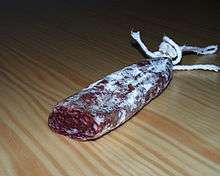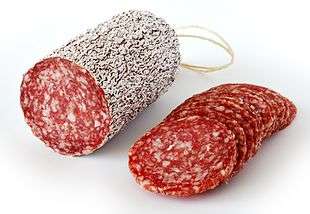Longaniza

Longaniza (Spanish pronunciation: [loŋɡaˈniθa], or American Spanish: [loŋɡaˈnisa]) is a Spanish sausage (embutido) similar to a chorizo and also closely associated with the Portuguese linguiça. Its defining characteristics are interpreted differently from region to region. It is popular in the cuisines of several regions of Spain, Puerto Rico, Dominican Republic, El Salvador, Mexico, Chile, Argentina, Uruguay and the Philippines.
Varieties by country
Spain
In Spain, longaniza are long thin salchichón that differ from chorizo in that they substitute black pepper for paprika and may have different spices like nutmeg.[1]
Argentina and Uruguay
In Argentina and Uruguay, longaniza is a very long, cured and dried pork sausage that gets its particular flavour from ground anise seeds. This results in a very particular aroma, and a mildly sweet flavour that contrasts with the strong salty taste of the stuffing. It is used mainly as an appetizer or in sandwiches, and very rarely cooked.
Chile
In Chile, longaniza may be eaten during a barbecue with bread as a choripan. The city of Chillán is known for its longanizas. Chillán's football team Ñublense are nicknamed The Clockwork Longaniza (Spanish:La longaniza mecánica). During the festivities of the 18th of September, longaniza is prepared in great quantities.
Mexico
Mexican longaniza tends to be longer than Mexican chorizo and is spicier.[2]
Puerto Rico
Puerto Rican style longaniza is made of pork, but also is made with chicken or turkey. The red orange color is from the addition of annatto seeds. Rice with longaniza is a popular dish.
Dominican Republic
Since colonial times, Dominican style longaniza has been prepared with the juice of bitter oranges (or lime), garlic, oregano and salt. For the casing, pork intestines are used. Then the longaniza is left to cure in the sun for some days. It is eaten fried in its own fats or in vegetable oil. Quality varies considerably because it is generally home-made. Best quality longaniza usually has a 70% lean fat content.
Philippines
Longganisa refers to sausages flavoured with indigenous spices, with each region or province having its own variation.[3] Among others, Lucban is known for its garlic-laden longanizas (derecado, "spiced"); Guagua for its salty, almost sour, variety. Longganisang hamonado (from the Spanish: longaniza jamonada), by contrast, is known for its distinctively sweet taste.
Unlike Spanish chorizo, Filipino longganisa can also be made of chicken, beef, or even tuna. Commercial varieties are made into links, but homemade sausages may be simple patties.[3]
See also
References
- ↑ Marbella Guide. Chorizo, the quintessential Spanish sausage.
- ↑ Grygus, Andrew. Sausages & the Like. Retrieved December 25, 2010.
- 1 2 Zeldes, Leah A. (2010-05-19). "Eat this! Longganisa, sweet Filipino sausage". Dining Chicago. Chicago's Restaurant & Entertainment Guide, Inc. Retrieved 2010-05-21.

